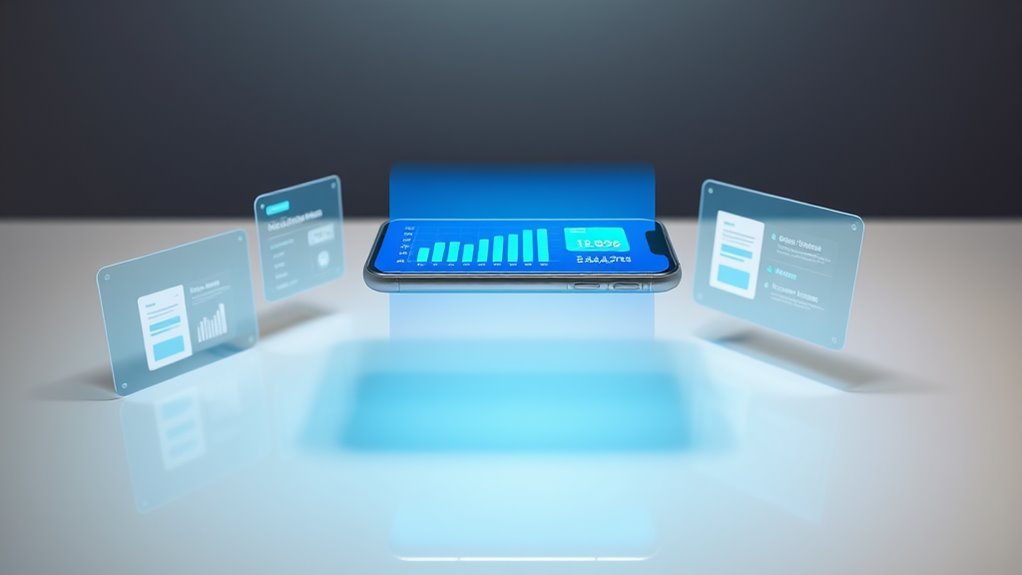Email marketing stands as one of today's most effective digital strategies, delivering an impressive $42 return for every $1 spent. You'll find it outperforms social media with conversion rates of 15.11% compared to 2.49%, while automated campaigns can boost revenue by 320%. Through personalized content and segmentation, you can build stronger customer relationships at just $0.05 per prospect, compared to $7 for direct mail. The strategy particularly shines for B2B companies, achieving 47% higher ROI through targeted campaigns. When you're ready to maximize your marketing efforts, understanding the nuances of email campaigns will reveal significant growth potential.
Key Takeaway
- Email marketing delivers an exceptional ROI of $42 for every $1 spent, making it one of the most cost-effective marketing strategies.
- Email campaigns achieve a 15.11% conversion rate, significantly outperforming social media's 2.49% conversion rate.
- Segmented and personalized email campaigns can increase revenue by 760% through targeted messaging to specific audience groups.
- Automated email workflows generate 320% more revenue than non-automated campaigns while reducing manual workload.
- With a cost of $0.05 per prospect compared to $7 for direct mail, email marketing provides scalable customer engagement.
Email Marketing ROI Statistics
Three key statistics demonstrate email marketing's exceptional return on investment. According to recent industry data, you'll see an average return of $42 for every $1 spent on email marketing campaigns, making it one of the most cost-effective digital marketing strategies available.
Key ROI Metrics to Evaluate:
- Conversion rates average 15.11% for email marketing, compared to 2.49% for social media
- Segmented email campaigns drive a 760% increase in revenue
- Automated email workflows generate 320% more revenue than non-automated campaigns
Your Industry-Specific Benefits:
- B2B companies achieve 47% higher ROI through targeted email campaigns
- E-commerce businesses see a 45% increase in customer lifetime value
- Service-based businesses report 39% higher client retention rates
To maximize your email marketing ROI, you'll need to focus on these proven strategies:
- Implement list segmentation based on customer behavior
- Create automated welcome sequences
- Deploy abandoned cart recovery emails
- Test subject lines and delivery times
- Track engagement metrics consistently
With these statistics and strategies in mind, you're well-positioned to leverage email marketing's impressive ROI potential for your business growth.
Benefits for Small Business Growth
Small businesses can leverage email marketing to accelerate growth without draining their limited resources. When you're operating with a tight budget, you'll find that email marketing delivers exceptional value while maintaining direct connections with your customers.
Key Growth Benefits for Your Small Business:
- Cost-Efficient Customer Acquisition – You'll spend approximately $0.05 to reach a prospect through email, compared to $7 through direct mail, making it an affordable way to expand your customer base.
- Direct Revenue Generation – Through targeted promotional campaigns, you can convert subscribers into buyers, with automated email sequences generating up to 320% more revenue than non-automated emails.
- Brand Authority Building – By delivering valuable content directly to your subscribers' inboxes, you'll establish yourself as an industry expert while nurturing long-term relationships.
- Scalable Customer Engagement – Your email list becomes a valuable business asset that grows with your company, allowing you to reach thousands of customers simultaneously without increasing costs proportionally.
Building Customer Relationships Through Email

Every successful email marketing campaign hinges on building meaningful connections with your subscribers. When you prioritize relationship-building over immediate sales, you'll create lasting customer loyalty that drives sustainable growth.
Key Relationship-Building Strategies:
- Personalize your content beyond just using first names – segment your audience based on their behaviors, preferences, and purchase history
- Deliver value-focused content that addresses specific pain points in your subscribers' journey
- Maintain consistent communication through automated welcome sequences, birthday messages, and milestone acknowledgments
Best Practices for Engagement:
- Keep your sender name consistent and recognizable
- Write conversational subject lines that spark curiosity
- Respond promptly to subscriber replies and feedback
- Share behind-the-scenes content to humanize your brand
You'll want to track engagement metrics like open rates, click-through rates, and response rates to gauge relationship strength. Research shows that segmented email campaigns generate 14.31% higher open rates than non-segmented campaigns. Don't forget to regularly clean your email list and remove inactive subscribers to maintain healthy engagement levels. Remember, strong customer relationships lead to increased customer lifetime value and more referrals for your business.
Essential Email Campaign Best Practices
Successful email campaigns rely on fundamental best practices that maximize impact and drive results. You'll need to implement proven strategies that enhance deliverability, engagement, and conversion rates while maintaining professional standards across your communications.
To guarantee your campaigns perform at their best, focus on these critical elements:
- Segment your audience precisely – Create targeted lists based on demographics, behavior, and purchase history to achieve up to 760% higher revenue from segmented campaigns
- Optimize for mobile devices – Design responsive emails that display perfectly across all devices, as 61% of emails are now opened on mobile
- Craft compelling subject lines – Keep them under 50 characters, include action words, and test variations to improve open rates by 35%
- Monitor and adjust timing – Schedule sends based on your audience's active hours and test different days for maximum engagement
Remember to consistently test your campaigns using A/B testing methods to refine your approach. Track key metrics like open rates, click-through rates, and conversion data to make data-driven improvements. You'll want to maintain a clean email list by regularly removing inactive subscribers and validating addresses to guarantee high deliverability rates.
Common Email Marketing Challenges

Despite the potential for high ROI, email marketing comes with significant obstacles that can hinder campaign performance. You'll need to navigate these common challenges strategically to achieve your desired results.
Key Email Marketing Challenges:
- Deliverability Issues
- ISP filtering and spam folders can prevent 20% of your emails from reaching inboxes
- Authentication protocols (SPF, DKIM, DMARC) require proper setup and maintenance
- List Management Hurdles
- Subscriber churn rates average 25-30% annually
- Maintaining list hygiene while growing your database demands constant attention
- Competition for Attention
- The average professional receives 121 emails daily
- You're competing against sophisticated marketers for limited attention spans
- Technical Complexities
- Mobile responsiveness across devices
- Email client rendering inconsistencies
- Integration with existing marketing tools
- Compliance and Regulations
- GDPR, CAN-SPAM, and other regulatory requirements
- Documentation and consent management
To overcome these challenges, you'll need to implement robust testing protocols, maintain clean lists, and consistently monitor key metrics. Focus on delivering value-driven content while staying current with technical requirements and regulatory changes.
Measuring Email Marketing Success
Tracking the right metrics forms the foundation of any effective email marketing program. You'll need to monitor key performance indicators (KPIs) that align with your business objectives, enabling data-driven decisions for campaign optimization.
Essential Email Marketing Metrics:
- Open Rate: Measure the percentage of recipients who open your emails, typically ranging from 15-25% across industries. This indicates your subject line's effectiveness and sender reputation.
- Click-Through Rate (CTR): Track the percentage of readers who click on your email links, with healthy rates falling between 2-5%. This reveals your content's engagement power.
- Conversion Rate: Monitor how many readers complete desired actions, such as purchases or sign-ups. Industry standards range from 1-5%, depending on your goals.
- Return on Investment (ROI): Calculate the revenue generated per dollar spent on email marketing, with the average being $42 for every $1 invested.
Beyond these core metrics, you'll want to analyze bounce rates, unsubscribe rates, and list growth rate. By regularly reviewing these indicators, you can refine your strategy, segment your audience more effectively, and maximize your campaign's impact.
Future of Email Marketing

In light of rapid technological advancement, email marketing continues to evolve with innovative features and sophisticated targeting capabilities. You'll see significant shifts in how brands connect with audiences through email, driven by AI integration and enhanced personalization.
Key Future Trends:
- AI-powered content generation will help you create more relevant, personalized emails at scale
- Interactive emails featuring in-email purchases, surveys, and appointment booking
- Enhanced privacy measures adapting to stricter data protection regulations
- Predictive analytics helping you determine ideal send times and content preferences
- Voice-activated email engagement as smart speakers become more prevalent
What You'll Need to Adapt:
- Mobile-first design will become non-negotiable, with over 85% of emails being opened on mobile devices
- Real-time personalization using dynamic content blocks
- Integration with other marketing channels for seamless customer journeys
- Implementation of AMP (Accelerated Mobile Pages) for email
You'll need to focus on hyper-personalization while respecting privacy concerns. The future of email marketing isn't just about sending messages – it's about creating interactive, personalized experiences that seamlessly integrate with your overall marketing strategy.
Conclusion
Email marketing remains a powerhouse strategy that's worth its weight in digital gold. Like a well-tended garden, your email campaigns will flourish when you invest time in personalization, automation, and data-driven decisions. You'll find that building genuine connections through targeted emails isn't just cost-effective—it's essential for modern business growth. Take the leap into email marketing, and you'll watch your ROI soar while nurturing lasting customer relationships.









